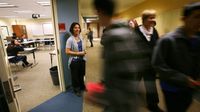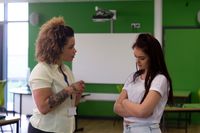It’s a dry, hot day in south Phoenix, but my dimly lit classroom is cool and comfortable. Quick footsteps approach outside the door and two-dozen 8- and 9-year-olds return from recess, sweating and smiling. They calmly walk to their desks while a children’s mindful breathing video plays on the whiteboard. Some students quietly grab their water bottles and head out to fill them up, and others sit on the carpet and stretch. While this happens, I watch four students pass by their desks and head straight to the table in the corner of the room to sit in a small circle.
Maria is speaking about an interaction at recess that left her feeling excluded. Gabriella starts to speak over her. Before she can finish her sentence, Ariel says, “Please wait until it is your turn, remember, everyone will get a chance to speak.” Gabriella nods and patiently waits her turn. After a few more minutes, Ariel turns to Maria and asks, “What can we do to make this right? How can we make sure this doesn’t happen again?” At that moment, I was absolutely amazed by the four children in my classroom. Only a few months before these same students came in from recess in tears, shouts, or both nearly every day.
In order to get to that point, I had to do a lot more than simply teach students the skills to engage in a conflict resolution dialogue. Students were able to independently work through that moment because we had spent a significant amount of time intentionally building the mindsets and relationships necessary to do so. As an early-career educator, I instinctively turned towards the approaches I’ve been taught by my own relatives and many other Indigenous teachers, to nurture, sustain and repair community. It took nearly two years of using these approaches to realize that other educators were doing the same thing, but they were calling it restorative justice or restorative practices.
Restorative Practices or Restorative Justice?
In my conversations with other educators, there is usually confusion around the definition of restorative practices due to the common emphasis placed on restorative justice, which focuses on repairing relationships when harm has occurred as an alternative to punitive approaches to discipline. In contrast, restorative practices focus on not only repairing, but also building and strengthening relationships and social connections within communities. The mainstream conception of restorative justice is credited to Howard Zehr and is thought to have originated within the criminal justice system in the 1970s. However, a 2017 report from the Zehr Institute for Restorative Justice, notes the growing demand from the field that practitioners acknowledge many of the values and practices of restorative justice come directly from Indigenous communities in North America and across the globe.
In fact, my own understanding of restorative practices is rooted in first-hand experiences of learning from Indigenous peoples implementing this way of being in their communities. In college, I had the opportunity to travel to the tribal headquarters of various Native Nations to learn directly from tribal leaders through the Native American studies program. For a federal Indian law course, we traveled to Window Rock, Ariz., to learn about the Navajo Nation’s peacemaking courts.
The Diné (Navajo) community uses peacemaking to resolve domestic disputes in a way that prioritizes restoring balance and harmony to the entire community. We discussed how restorative justice as a philosophy and set of practices more closely aligns with Indigenous knowledge systems than dominant criminal justice approaches in the U.S. Years later, as I started to explore the field of restorative justice as an educator, I realized how rare my perspective was and how it impacted my understanding and use of restorative practices in my classroom.
Going Beyond Repairing Harm
While others saw restorative justice as a way to transform their behavior management or discipline, I conceptualized it as a holistic framework for not only repairing, but nurturing and sustaining relationships with and among the classroom community. When I taught first grade, we started every day with a community circle, where each student was given the opportunity to respond to a daily question or prompt. Students were encouraged to actively listen to their peers and share openly or respectfully pass when it came their turn to speak. Sometimes called talking circles, this is a commonly shared technical protocol within restorative practices, but to me, it was the style and form of communication I had experienced in various settings with Indigenous peoples my whole life.
Within my own culture, circles are often used symbolically and literally for their ability to promote equity, interconnection and holism. My mother, the current chairwoman of the Standing Rock Sioux Tribe, has said that as Lakota people, “we live in a circle way—the sacred hoop relates to every aspect of our way of life.” A central belief of Lakota people, and many other Indigenous communities, is the idea that we are all related. All living beings, including animals, plants, lands and waters have inherent worth because we are all an integral part of a larger interdependent system. This concept of relationality is foundational within a restorative practices philosophy, but educators rarely have the chance to consider how this mindset can impact the design of their instruction or the structure of their classrooms.
Learn from Indigenous Ways of Being
After much self-reflection, I recognize now I was comfortable applying this idea of relationality in the classroom because I was socialized in a community that exhibited the foundational values, beliefs, and mindsets needed for a restorative way of being. I also recognize that is not the case for the majority of educators in classrooms.
Even so, the realization motivated me to consider how restorative practices can be implemented not only in my classroom management but also my instructional choices. I designed lessons that created authentic contexts for students to practice the skills needed to maintain healthy relationships. Our classroom communities found success repairing harm with restorative practices because students proactively developed meaningful relationships with not only me but each other as well.
As more and more schools turn to restorative practices, I encourage all interested educators to center and learn from Indigenous communities who have been implementing restorative practices as a holistic way of being since time immemorial.





 Jigsaw is a cooperative learning strategy that enables each student of a “home” group to specialize in one aspect of a topic (for example, one group studies habitats of rainforest animals, another group studies predators of rainforest animals). Students meet with members from other groups who are assigned the same aspect, and after mastering the material, return to the “home” group and teach the material to their group members. With this strategy, each student in the “home” group serves as a piece of the topic’s puzzle and when they work together as a whole, they create the complete jigsaw puzzle.
Jigsaw is a cooperative learning strategy that enables each student of a “home” group to specialize in one aspect of a topic (for example, one group studies habitats of rainforest animals, another group studies predators of rainforest animals). Students meet with members from other groups who are assigned the same aspect, and after mastering the material, return to the “home” group and teach the material to their group members. With this strategy, each student in the “home” group serves as a piece of the topic’s puzzle and when they work together as a whole, they create the complete jigsaw puzzle. Before reading
Before reading During reading
During reading
